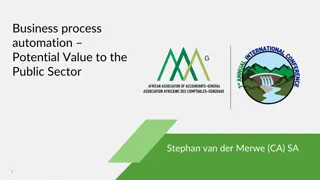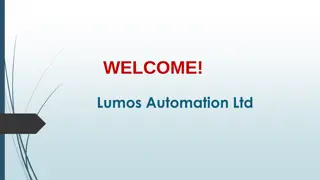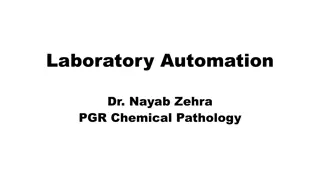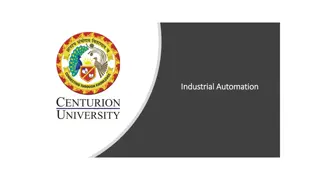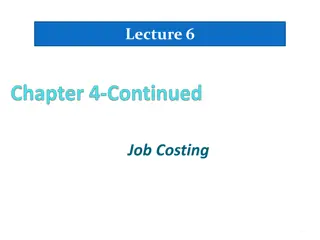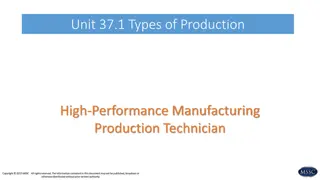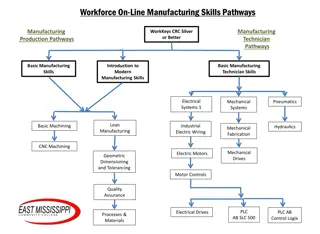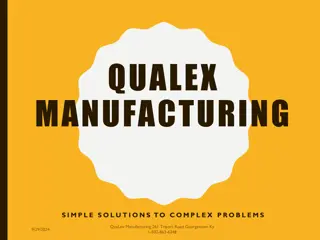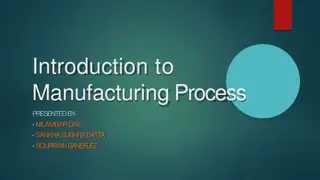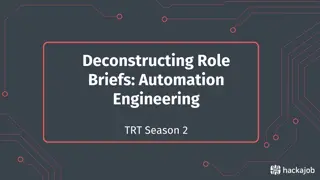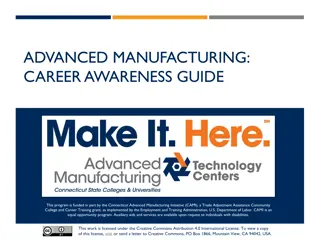Evolution of Manufacturing Systems: From Handicraft to Automation
The evolution of manufacturing systems traces back to manual craftsmanship and has progressed into automated processes using machines and computerization. Specialization of tasks, organization of production systems, and different categories of manufacturing methods have played crucial roles in shaping modern manufacturing practices. Automation, featuring semiautomated and fully automated systems, showcases reduced human involvement compared to manual processes. Explore the journey from handcrafted goods to advanced manufacturing in this insightful read.
Download Presentation

Please find below an Image/Link to download the presentation.
The content on the website is provided AS IS for your information and personal use only. It may not be sold, licensed, or shared on other websites without obtaining consent from the author.If you encounter any issues during the download, it is possible that the publisher has removed the file from their server.
You are allowed to download the files provided on this website for personal or commercial use, subject to the condition that they are used lawfully. All files are the property of their respective owners.
The content on the website is provided AS IS for your information and personal use only. It may not be sold, licensed, or shared on other websites without obtaining consent from the author.
E N D
Presentation Transcript
The word manufacturing derives from two Latin words, manus (hand) and factus (make). This was the way manufacturing was accomplished Commercial goods of those times were made by hand. The methods were handicraft, accomplished in small shops, and the goods were relatively simple As many years passed, factories came into being, with many workers at a single site, and the work had to be organized using machines rather than handicraft techniques. The products became more complex, and so did the processes to make them.
Workers had to specialize in their tasks. Rather than overseeing the fabrication of the entire product, they were responsible for only a small part of the total work. More up-front planning was required, and more coordination of the operations was needed to keep track of the work flow in the factories Slowly but surely, the systems of production were being developed. The systems of production are essential in modern manufacturing.
A production system is a collection of people, equipment, and procedures organized to perform the manufacturing operations of a company. In modern Manufacturing operations, portions of the production system are automated and/or computerized.
Three categories of manufacturing systems (a) manual work system (b) worker-machine system (c) fully automated system
An automated system is one in which a process is performed by a machine without the direct participation of a human worker. Automation is implemented using a program of instructions combined with a control system that executes the instructions. Two levels of automation can be identified: semiautomated and fully automated. A semiautomated machine performs a portion of the work cycle under some form of program control, and a human worker tends to the machine for the remainder of the cycle, by loading and unloading it, or by performing some other task each cycle. A fully automated machine is distinguished from its semiautomated counterpart by its capacity to operate for an extended period of time with no human attention.
They are called automated because they perform their operations with a reduced level of human participation compared with the corresponding manual process. Examples, Automated machine tools that process parts Transfer lines that perform a series of machining operations Automated assembly systems Manufacturing systems that use industrial robots to perform processing or assembly operations Automatic material handling and storage systems to integrate manufacturing operations Automatic inspection systems for quality control.
Automated manufacturing systems can be classified into three basic types: (1) Fixed automation (2) programmable automation (3) flexible automation
It is a system in which the sequence of processing (or assembly) operations is fixed by the equipment configuration Simple operations like plain linear or rotational motion or an uncomplicated combination of the two, such as feeding a rotating spindle It is the integration and coordination of many such operations in one piece of equipment that makes the system complex. Typical features of fixed automation are (1) high initial investment for custom-engineered equipment, (2) high production rates, and (3) inflexibility of the equipment to accommodate product variety. The high initial cost of the equipment can be spread over a very large number of units, thus minimizing the unit cost relative to alternative methods of production.
The production equipment is designed with the capability to change the sequence of operations to accommodate different product configurations The operation sequence is controlled by a program New programs can be prepared and entered into the equipment to produce new products. Some of the features that characterize programmable automation include, (1) high investment in general-purpose equipment, (2) lower production rates than fixed automation, (3) flexibility to deal with variations and changes in product configuration and (4) high suitability for batch production
Programmable automated systems are used in low- and medium-volume production. The parts or products are typically made in batches. The physical setup of the machine must also be changed This changeover takes time. Consequently, the typical cycle for a given batch includes a period during which the setup and reprogramming take place, followed by a period in which the parts are produced.
Flexible automation is an extension of programmable automation There is no lost production time while reprogramming the system and altering the physical setup What makes flexible automation possible is that the differences between parts processed by the system are not significant, so the amount of changeover between designs is minimal. Features of flexible automation include (1) high investment for a custom-engineered system, (2) continuous production of variable mixtures of parts or products, (3) medium production rates, and (4) flexibility to deal with product design variations.
Increase labor productivity Reduce labor cost Mitigate the effects of labor shortages Reduce or eliminate routine manual and clerical tasks Improve worker safety Improve product quality Reduce manufacturing lead time Accomplish processes that cannot be done manually Avoid the high cost of not automating
The USA Principle is a commonsense approach to automation and process improvement projects. USA stands for (1) understand the existing process, (2) simplify the process, and (3) automate the process. The USA approach is so general that it is applicable to nearly any automation project Going through each step of the procedure for an automation project may in fact reveal that simplifying the process is sufficient and automation is not necessary.
Understand the Existing Process: The first step in the USA approach is to comprehend the current process in all of its details. Simplify the Process: Once the existing process is understood, then the search begins for ways to simplify. This often involves a checklist of questions about the existing process. Automate the Process: Once the process has been reduced to its simplest form, then automation can be considered.
Specialization of operations Combined operations Simultaneous operations Integration of operations Increased flexibility Improved material handling and storage On-line inspection Process control and optimization Plant operations control Computer-integrated manufacturing (CIM)
A typical automation migration strategy is the following: Phase 1: Manual production using single-station manned cells operating independently. This is used for introduction of the new product for reasons already mentioned: quick and low-cost tooling to get started. Phase 2: Automated production using single-station automated cells operating independently. As demand for the product grows, and it becomes clear that automation can be justified, then the single stations are automated to reduce labor and increase production rate. Work units are still moved between workstations manually. Phase 3: Automated integrated production using a multi-station automated system with serial operations and automated transfer of work units between stations. When the company is certain that the product will be produced in mass quantities and for several years, then integration of the single station automated cells is warranted to further reduce labor and increase production rate.
There are several advantages of such a strategy: It allows introduction of the new product in the shortest possible time, since production cells based on manual workstations are the easiest to design and implement. It allows automation to be introduced gradually (in planned phases), as demand for the product grows, engineering changes in the product are made, and time is provided to do a thorough design job on the automated manufacturing system. It avoids the commitment to a high level of automation from the start, because there is always a risk that demand for the product will not justify it.






